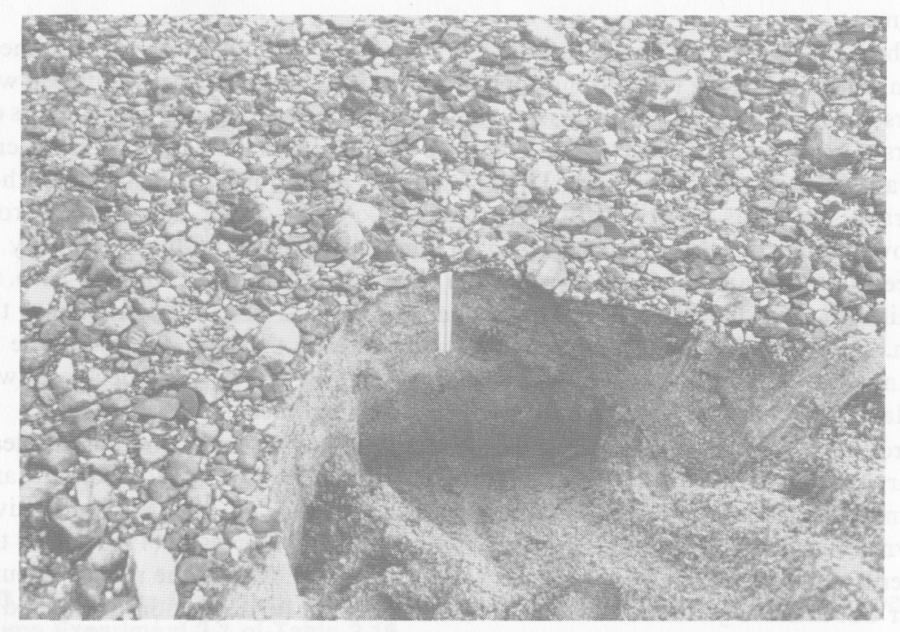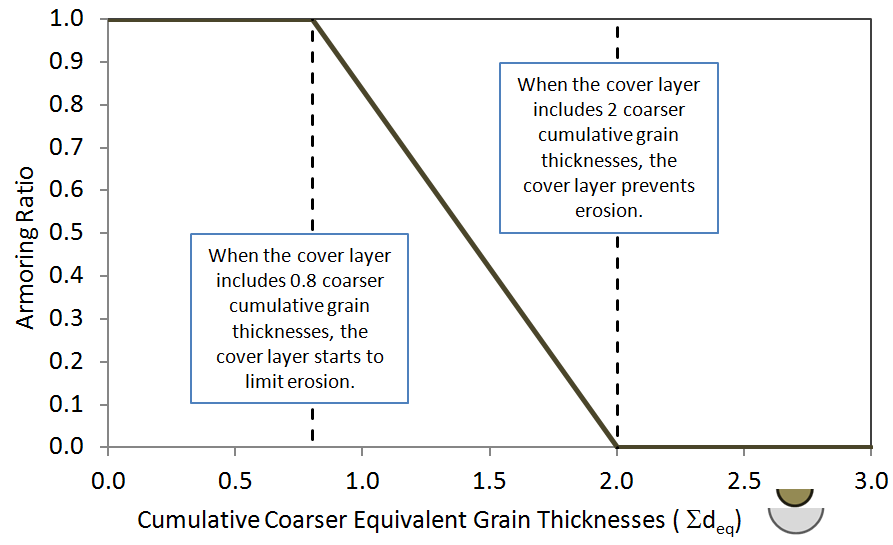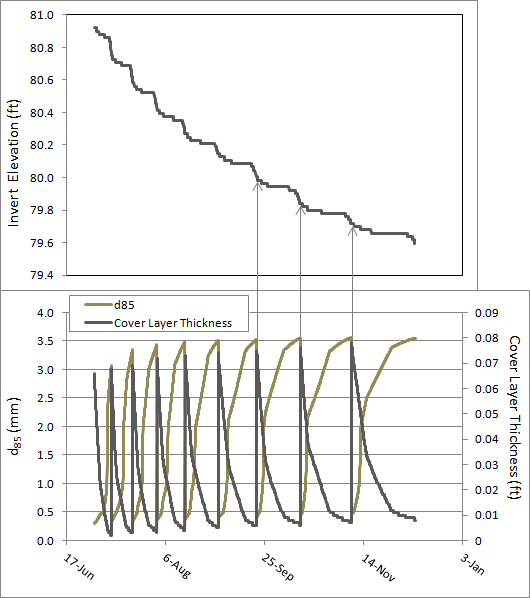Download PDF
Download page Thomas Mixing Method (Exner 5).
Thomas Mixing Method (Exner 5)
The Thomas method (formerly Exner 5) is the default sorting and armoring method in HEC-RAS. This is a three-layer bed mixing algorithm, which was designed to account for the influences of static armoring. Tony Thomas developed this method (Thomas, 1982), which was the default method in HEC-6. It subdivides the active layer into a cover layer and a subsurface layer, allowing a thin cover layer to coarsen and regulate erosion, while maintaining the more broadly graded active layer. HEC-RAS computes transport capacity computation based on the gradation of the entire active layer, which includes the combined cover and subsurface layers. Sediment deposits into and erode from the cover layer. Thomas developed this mixing algorithm based on the photograph in Figure 13-8 and the data in Harrison (1950).
If finer grain classes erode faster than coarser glasses (relative to their abundance) the cover layer coarsens, regulating the sediment that transport capacity can remove from the active layer. HEC-RAS can erode a grain class long as it is available in the cover layer. But once the model strips a grain class from the cover layer it will try to satisfy the grain class transport capacity with subsurface layer sediment. The cover layer can reduce or preclude erosion from the subsurface layer, leaving capacity unfulfilled.
The Copeland (1992) method followed the basic approach and architecture of the Thomas method made a few critical changes. The discussion that follows generally applies to both methods, then the algorithm elements particular to Copeland are discussed in the next section.
Active Layer and Equilibrium Depth:
The Thomas method computes the Active Layer (cover layer + subsurface layer) at the beginning of each time step by computing the Equilibrium Depth (Deq). Equilibrium Depth is the smallest water depth at which surface sediment does not move, where hydraulic forces are too small to move bed particles. Alternately, it is the maximum potential scour depth. Then it adjusts the active layer to the equilibrium depth (Figure 215).
Equilibrium Depth (Deq) is based on a relationship between hydraulic energy, bed roughness and sediment transport intensity. The Thomas method combines Manning's equation for flow velocity, Strickler's equation for grain roughness, and Einstein's Transport Intensity equation to compute equilibrium depth:
Manning's Equation
| V = \frac{1.49}{n} R^{\frac23} S_f^{\frac12} |
Strickler's Roughness Equation
| n = \frac{d^{\frac16}}{29.3} |
Einstein's Transport Intensity Equation
| \Psi = \frac{\rho_s - \rho_w}{\rho_w} \times \frac{d}{D\times S_f} |
Where:
V =Velocity
R =Hydraulic Radius
Sf =Friction Slope
n =Manning's n value
d =representative particle size
ρs =grain density
ρw =water density
D =Depth
The Einstein Equation assumes particle erosion when the transportability ≥30. Submerged particle density _(s-w/w{_}) is 1.65. Substitution reduces the Einstein's Transport Intensity equation to:
| S_f = \frac{d}{18.18D} |
HEC-RAS solves these three equations for unit water discharge by replacing the sub-sectional hydraulic radius in the Manning equation with the panel depth, D, and the n-value with Strickler's equation such that:
| q = \frac{1.49}{\left( \frac{d^{\frac16}}{29.3} \right)} \times D^{\frac53} \times \left( \frac {d}{18.18D} \right) ^{\frac12} |
or
| q = 10.21 \times D^{\frac76} \times d_i ^{\frac13} |
Where:
q = water discharge in cfs per ft of width
di = the particle diameter
D = is the depth that does not transport the grain class, or the equilibrium depth Deq.
Solving for Deq yields:
| D_{eq} = \left( \frac{q}{10.21 \times d_i^{\frac13}} \right) ^{\frac67} |
Where: Deq = Equilibrium depth for particle size, i
The Thomas method solves the equilibrium depth equation for each grain class, and sets the active layer thickness to the larges, which is the maximum possible scour.
Splitting the Active Layer: Cover and Subsurface Layers
Thomas' main innovation was dividing the active layer into two sub layers: a cover layer and a subsurface layer. The algorithm computes transport capacity based on the entire active layer, but he cover layer coarsens independently and regulates erosion from the rest of the active layer (the subsurface layer).
At the beginning of the bed mixing stage, HEC-RAS computes a new active layer thickness – based on the equilibrium depth. HEC-RAS carries the cover layer over from the previous time step but re-creates the sub-surface layer each time based on the new active layer thickness computed by equilibrium depth.
Equivalent Particle Diameter:
The Thomas function (and the Copeland method after it) computes cover layer armoring based on an equivalent particle diameter principle. This equivalent particle diameter can be difficult to conceptualize, but is central to understanding the algorithm.
The equivalent particle diameter (deq) converts the mass of each grain class into an equivalent thickness, expressed as a fraction or multiple of the grain class diameter. For example, if the large (grey) grain class in the figure below were spread evenly over the control volume, it would form a layer approximately half the particle diameter thick (half an equivalent particle diameter or 0.5deq). Likewise, if the medium (brown) grain class in the cover layer (below) would form a layer approximately 40% of its diameter thick if spread evenly over the entire control volume (deq=0.4). The equivalent particle diameter converts the cover layer mass of each grain class into a thickness, normalized to the grain class diameter.
Armoring Ratio:
The Thomas and Copeland methods both use the equivalent particle diameter to compute an Armor Ratio. The Armor Ratio is a coefficient between 0 and 1, which reduces the sediment deficit HEC-RAS will erode from the sub-surface layer, if the cover layer includes enough coarser material.
The Thomas algorithm has five basic steps:
- Compute Sediment Deficit by Grain Class: First HEC-RAS computes transport capacity for each grain class and compares it to supply. If capacity exceeds supply, it tries to erode the deficit from the bed.
- Sum the Equivalent Particle Diameters of all coarser grain classes in the cover layer: Before HEC-RAS removes any sediment from the sub-surface layer, it computes the equivalent particle diameter of every coarser grain class in the cover layer, and then sums them.
- Remove the Grain Class Mass from the Cover Layer: If the cover layer contains the enough of the grain class, HEC-RAS removes the entire deficit from the cover layer. If the cover layer does not have enough of the grain class to satisfy the deficit, HEC-RAS removes all of the grain class from the cover layer, and then tries to remove the balance from the sub-surface layer. For example, in the simplified substrate in the figure above, if HEC-RAS tried to remove the smallest grain class (green), it would sum the equivalent diameter of the two coarser grain classes. HEC-RAS uses the sum of the equivalent grain diameters for cover layer grain classes, coarser than the eroding grain class (Σdeq=0.9 in the figure above) to compute armor layer regulation (i.e. reduce the amount of deficit the model can erode from the sub-surface layer).
- Compute an Armoring Ratio: The Thomas method computes an armor ratio from the cumulative coarser equivalent diameter according to the relationship in the figure below. This relationship interpolates between a low bound, where the cover layer has no effect on erosion and an upper bound where the armor layer totally prevents erosion from the subsurface layer.

Low Bound: If there is less than one total cumulative equivalent diameter of coarser material in the cover layer (Σdeq<1), then the cover layer can't be continuous. For Σdeq<0.8, 20% of the subsurface layer is exposed. At this thickness, the method assumes the cover layer has too many gaps to regulate the subsurface layer. The Thomas method does not reduce erosion for this case.
High Bound: On the other extreme, if the sum of the equivalent grain diameters of coarser grain classes is greater than 2 (Σdeq>2) the cover layer will not allow any erosion of that grain class from the sub surface layer. This end point comes from broad empirical evidence that flow cannot 'suction' fine sediment through more than two grain diameters of immobile armored layer.
The Thomas method interpolates linearly between these end points:
No Armoring (Armor Ratio = 1 → erosion =deficit) for Σdeq<0.8 and
No Erosion (Armor Ratio = 0 → erosion =0) for Σdeq>2.
5. Erode the grain class from the sub-surface layer, reducing the deficit by the Armor Ratio: HEC-RAS multiplies the sediment deficit for each grain class by the armor ratio such reducing erosion for each grain class (i) according to the expression: Erosion(i) = Armor Ratio(i) * Sediment Deficit For the example in Figure 216, where Σdeq=0.9, the Thomas method returns an armor ratio of 0.91, and HEC-RAS would remove 91% of the deficit of the fines grain class from the subsurface layer.(i)
Cover Layer Reset: Destruction or Burial
The cover layer evolves during the simulation, coarsening or fining in response to capacity and upstream load. However, there are two situations which cause the cover layer to 'reset,' which introduce bed gradation non-linearity. Understanding these processes will help interpret bed gradation results.
Cover Layer Destruction:
The cover layer can erode until it is too thin to regulate the bed. At that point, the Thomas method resets the layer, mixing it with the rest of the active layer, and cutting a new, thicker cover layer from the mixed active layer bed material.
At the beginning of each computation time step, HEC-RAS computes the stratification weight of the cover layer. The stratification weight is simply the combined equivalent particle diameter of all grain classes in the cover layer. If the stratification weight, the total cumulative equivalent particle diameter is less than 0.5, HEC-RAS destroys the cover layer. Thomas based the 0.5 threshold on Harrison's (1950) experiments, which demonstrated that equilibrium sediment transport dropped when 40% of the bed surface was covered in his flume experiments.
Cover layer destruction can generate gradation results that are difficult to interpret, like those in the figure below. This model eroded monotonically, and the capacity was high enough that the cover layer periodically slowed erosion but never stopped it. Therefore, as the bed eroded, the cover layer periodically coarsened, but as it coarsened it also thinned. When the cover layer thinned to less than 0.5 deqs, it reset, instantly fining as it adopted the gradation of the parent material. So, while the cover layer algorithm can form a static armor layer and keep the model from over-predicting erosion in graded sediment systems, cover layer dynamics also make it difficult to track gradation temporally or longitudinally (Gibson and Pridal, 2015). 
Cover Layer Burial:
HEC-RAS also resets the cover layer if deposition buries it. If the cover layer grows to 2 ft thick, the Thomas method assumes that the cover layer no longer exists as a distinct stratigraphic layer, and mixes the bed, resetting the cover layer with sediment from the mixed substrate. This feature is helpful in rapidly changing environments that alternate between deposition and armoring erosion, but can also introduce non-linear shifts in the gradation output.
The HEC-6 User's Manual includes more discussion on this mixing method, calling it Method 2 (p. 25)